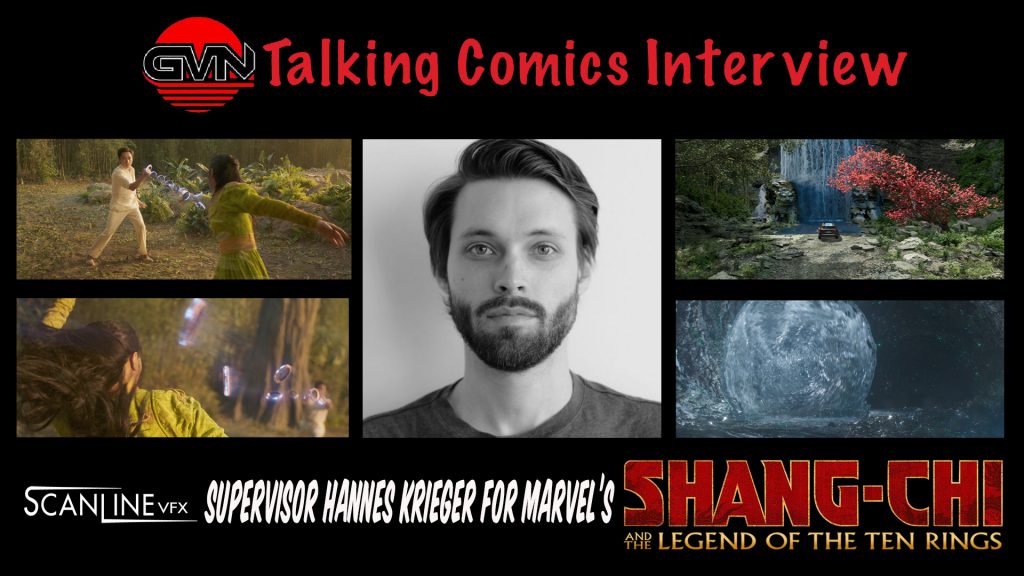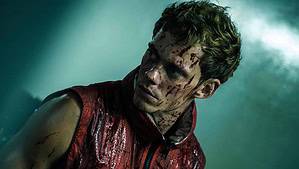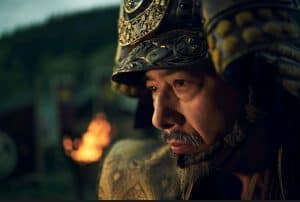As Marvel set about starting their Phase 4 for the Cinematic Universe, they knew they would be introducing fans to new characters. Perhaps not new to those who lived and breathed Marvel Comics, but new to the average fan. Shang-Chi, Master of the Martial Arts was one of these characters. Created by Steve Englehart and artist Jim Starlin, Shang-Chi debuted in Special Marvel Edition #15 (December 1973). The character went through a number of revisions over the years and has so again in the Marvel film adaptation. However, if the fan’s reactions to the film have been any evidence, the results have continued the expected Marvel Cinematic magic.
When it came time to bring the scenes to life with VFX, as per usual, Marvel enlisted the very best in the world of special effects. When that call came to them, as you would expect, our friends at Scanline VFX answered the bell. Such was the case for Shang-Chi and the Legend of the Ten Rings. Recently, we had some time to sit down with Scanline’s Hannes Krieger who was FX Supervisor for Shang-Chi. We discussed his career, his team’s work on the film and a little about his previous work on HBO’s Game of Thrones. So let’s welcome Scanline VFX’s Hannes Krieger.
Starting Out
GVN: Thank you for sharing some of your time Hannes. I know in your line of work you remain busy. So, let’s start with some of your background. When did you take an interest in VFX Work and was there a film or television show that inspired you to pursue that line of work?
HK: I first became interested in 3D when a friend showed me his own Half-Life multiplayer level created with the Hammer Editor when I must have been thirteen. I dove right into it and learned all the tools I could, from creating textures to building a level. At one point I competed in a 52 hour mapping competition for Counter-Strike and to my surprise, I came in fourth. So, I thought about going into game development but I figured at the time that the industry in Germany was too small and I wouldn’t stand a chance. Instead, I went for a media designer apprenticeship and didn’t pay much attention to anything 3D related. At least until I started studying Audiovisual Media much later which had computer animation and VFX courses.
Throughout my childhood, I caught pieces of VFX breakdowns, like the use of motion capture on Titanic or the use of CG for Jurassic Park. At Scanline I am now even working with some of the crew who were part of the Titanic production! Our Professor for VFX at the Stuttgart Media University introduced us to the full history of VFX. Her interest for the work on Blade Runner quickly ignited more interest in me. I did some FX work on one of the VFX projects at university and later that year, Pixomondo was on the outlook for someone to do some snow on a Martin Scorsese film (which went on to win the VFX Oscar.) So one thing led to another and in retrospect, I couldn’t have been more lucky.
Learning from the Best
GVN: You started out as an intern for Madness GmBH and then worked for Pixomondo. How did your work for them prepare you for your eventual move to Scanline VFX?
HK: At Madness I was surrounded by a small group of very talented 3ds Max generalists. It was here that I picked up 3ds Max for the first time and where I learnt a lot of the basics. One freelancer introduced me to FX and ThinkingParticles which I ended up using for a good chunk of my career. Later at Pixomondo, I was part of a small but exceptional FX team and was thrown onto many different FX projects right off the bat without knowing too much about how to execute them. Pixomondo Stuttgart was a fairly small team and I got to know people from all departments which gave me the chance to learn a lot about the whole VFX process and how to make a lot out of very little.
My time at Pixomondo eventually led me to Scanline where I suddenly had the chance to work on multiple bigger FX shots simultaneously which was very challenging. Surrounded by an amazing team of highly skilled FX artists, I learnt so much in a short period of time. Throughout my career I’ve always had either great mentors or like-minded people who I could absorb a lot of skills and workflows from.
Advancing at Scanline VFX
GVN: During your time at Scanline, you have gone from FX-Artist, FX Lead, FX Supervisor (and now Head Of FX for North America). As you advanced, were these jobs that you had worked toward or did your work garner enough attention that Scanline approached you to take on more responsibility?
HK: I would say a bit of both. Even though I consider myself an introvert, throughout my life I have filled different leadership roles. Whether it be in sport teams, in school or elsewhere. I did not have a particular goal of moving into these roles, but over time, it has come somewhat naturally. I’m good at solving problems and am very curious about the entirety of a process and how it could be improved further. I enjoy helping other artists and so they would often come to me for help. I can keep my calm during high pressure situations which helps my teams and I would also say I am a fair and supportive leader. At Scanline I had amazing support from the wider leadership team which made me comfortable with the idea of being able to fill these roles. I was asked if I was interested in being a lead at Scanline and once I saw the possibilities, I definitely pushed for it myself as well.
GVN: So what would you say is the most important part of being a lead?
HK: In my role, it is important to be responsible and proactive. I always try to be one step ahead. You can think of it this way: the less your superiors have to think about your team’s work and when it will be complete, the better of a job you are doing. I try to ease as much pressure as I can for both my team but also the team of supervisors. Every new role was intimidating and challenging at first but with trial and error, support and a lot of hard work I was able to fulfil and partially exceed the roles to step up into the next one. Scanline is a place with lots of opportunities for people especially now more than ever, due to how quickly it is growing and I have certainly benefited from that.
Prepping for Shang-Chi
GVN: Speaking of FX Supervisor, you served that function on Marvel’s Shang-Chi and the Legend of the Ten Rings. How much prep work was necessary once you knew what shots Scanline was going to be responsible for?
HK: The biggest preparation we had to do was figuring out the entire workflow for the moving bamboo forest. Traditionally the workflow is fairly linear. In this case we went from modeling to environment to rigging to animation to FX to lighting to composting. Usually departments can work in parallel, however, in this case, every department was heavily dependent on its upstream department. It was wild at first but in the end turned into a well-oiled machine, thanks to CG Supervisor Francesco Pinto and our DFX Supervisor Jessica Harris. And of course the added challenge of figuring out how to give thousands of trees believable movements while also giving them a certain character to make the sequence suspenseful.
This slideshow requires JavaScript.
Working with Marvel
GVN: I imagine doing work for Marvel carries its own levels of pressure. It’s Marvel after all. Are there any limitations or guidelines that Scanline has to factor in on a Marvel project or by now, is it just business as usual since you have produced so well for them in past films?
HK: This was my second Marvel project after “Spider-Man: Far from Home.” Generally we always like to challenge ourselves to do the best work possible. You always want to improve on the work delivered on previous projects. Marvel is special in regards to how many iterations and different creative directions you end up exploring. It keeps you on your toes throughout the project. Of course it is very rewarding to be part of movies of such sheer quality and especially given how big of an audience the Marvel Universe has.
Wen Wu Meeting Li
GVN: During your time on the film, Scanline produced 201 shots across two main sequences. Wen Wu Meeting Li and the fight that ensued, and the Moon Gate Arrival. What were the challenges faced in the Wen Wu Meeting Li sequence?
HK: For FX, the challenge was to not take away from the fight choreography and make the FX blend in seamlessly while also adding value to the sequence. Christopher Townsend, the Overall VFX Supervisor, gave us direction to make the fight feel like a graceful dance. We worked on a sort of energy effect radiating from Xiang Li’s body to visualize her powers. The leaves, dust and dirt were only secondary at that time. While the effect looked pretty cool, tying in well with Xiang Li’s motion, it didn’t make it into the movie as it pulled too much of the attention and it wasn’t what the filmmakers were after. The focus then shifted more and more towards the leaves themselves.
The Qi
GVN: You were also responsible for showing their powers for that shot. With that in mind, what went into creating their individual superpowers, “The Qi” and “The Rings?”
HK: The Qi in the end was made up of the elements of leaves, dirt and dust. Everything related to the Qi and had to follow Xiang Li’s motion. We worked closely with the layout and animation departments under Mattias Brunosson’s supervision who provided us with gracefully animated guide geometry to have the leaves and dirt follow. The Qi is an extension of Xiang Li’s hand, arm and leg movements. Whenever her arm sways, you see a stream of leaves follow. We spent a lot of time sorting out the continuity from one shot to another to make sure the leaves had a nice flow throughout the sequence. Worth mentioning is that we simulated our dust as a flip simulation in Flowline opposed to purely grid based. This means our dust is made up out of millions of tiny dust particles which gave the dust more of a gritty feeling.
The Rings
The Rings initial setup was done by Method Studios in Melbourne from which we received visual references and their Houdini setup. We took that and started our own dev work in FX for specific actions in our sequences. For example, what does it look like when he shoots the rings, when he receives them or when he uses them to propel himself in the air? We sent a lot of layers to our compositing team and had them help us figure out a lot of the visual layering, coloring and how the rings distort their environment. They came up with something very pleasing to look at. The initial look got changed over time and kept changing until the end where it eventually turned into a big mix of different setups from us and various vendors depending on the specific action. Ideas and visuals were sent across the planet and in the end, I believe one of the Houdini setups combined elements from 3 different companies.
This slideshow requires JavaScript.
GVN: Did you face any unforeseen obstacles while creating that fight sequence?
HK: Mainly the shift from the more energy based Qi FX to only having the leaves. It changed how we had to approach the sequence as a whole half way through. We were also working on some bigger tornado-like Qi FX which would blast waves through the forest but it later got omitted.
The Moon Gate
GVN: How about Challenges in Moon Gate Arrival Sequence? I know that water manipulation is one of Scanline’s strengths so creating a digital waterfall and the water portal was probably right up Scanline’s alley.
HK: Water is definitely something we have done before. The waterfall was rather straightforward in terms of what it had to look like. Once they drove through the waterfall into the Moongate, it became more abstract and we had to turn the waterfall from a gravity abiding simulation into a floating one. The challenge here was to make the transition readable for the audience and have the water transition from streaming down to clumping up and floating over the windshield with the camera being in the middle of it. After that we entered into a sort of void where the water was just calmly floating around the car. We were trying to balance between the water ripping apart but also holding its structure and surface.
For the portal itself, we experimented with quite a few different shapes, forms and dynamics. It had to tie into the portal language of the Marvel Universe. One variant was to have the portal look like a water version of the Doctor Strange portal. You can especially get that feeling from the portal opening. We ended up combining multiple of the versions to one. In the movie you see 2 portals going against each other on the outside and the inside plus some additional layers for the depth and detailing.
This slideshow requires JavaScript.
The Bamboo Forest
The bamboo forest labyrinth leading to the Moon Gate also turned out to be very challenging. There was quite a bit of back and forth between the animation, environment and FX departments. Once the forest environment was built on a shot, animation had to run a first test with the trees moving to see how the environment worked through the camera and the progression of the shot. After that, FX took the tree animation and ripped up the ground with a grain simulation, simulated the plants, small and big bamboos. Any time either the environment or the animation department changed something, the process began from the beginning. The grains were rendered as points for anything in the distance and instanced geometry for close up shots. The plants on the ground had multiple layers of various types which got advected by the grains and tree animation. Some of them fully dynamic, some pre-cached and instanced.
Seeing the Forest and the Trees
For the trees, typically we would use some instancing trickery, but on this project, we decided to go with fully dynamic simulations for every single tree. We spent quite a bit of time figuring out how to process all this data and how to get it rendered without running out of memory. Nicolas Aithadi, our VFX Supervisor, helped us push the complexity without compromising the sequence visually. In the end, we rendered the trunks as their original geometry point deformed to their dynamic simulations, saved the branches as “hair” with UVs, instanced the leaves per type of tree and decimated both the polycounts and amount of leaves by importance of the camera view. We further had to split the forest into sections which also allowed for splitting the simulations and renderings. It was later put back together by the compositing team.
GVN: Same question, were there any glitches that you ran into during this sequence? (I ask this for both scenes because I have learned from past interviews that when things go wrong, that it generally brings out the creative best in a team).
HK: The closest we came to something you could call a glitch is the different energy Qi FX we were playing with in the beginning of the show. As these FX were heavily dependent on Li’s movement we got some really interesting shaped forms depending on which shot we put the FX setup in. We then picked the bits and pieces we liked the most and tried to reproduce them in other shots with completely different movements. You could imagine it as long exposure photography motion paths mixed with magnetic fields.
Game of Thrones
GVN: Thank you so much, Hannes for indulging us about your craft. Before I let you go, I noticed that in your work for Pixomondo, you did work on Season 2 and 3 for one of my favorite shows Game of Thrones. Do you have any memories about your work on that show you can share?
HK: When the work on Season 2 started I couldn’t have imagined how big Game of Thrones would get. Apart from doing a lot of snow, my greatest memory is from working on the shadow birth scene with Melisandre and Stannis. When the shots were aired I went online to check out some of the reactions of people watching the scenes. It was very rewarding to see people’s disgusted faces and also watch them scream. A reaction I most likely only enjoy in this context!
GVN: I remember it well. Thanks again Hannes and we look forward to our next opportunity to explore the VFX Magic that IS Scanline VFX. Marvel’s Chang-Chi and the Legend of the Ten Rings can be still seen at select Theaters and will be making its Disney+ debut on November 12th.
Before we let you go, we have officially launched our merch store! Check out all of our amazing apparel when you click here and type in GVN15 at checkout for a 15% discount!
Make sure to check out our podcasts each week including Geek Vibes Live, Top 10 with Tia, Wrestling Geeks Alliance and more! For major deals and money off on Amazon, make sure to use our affiliate link!

Senior Writer at GeekVibesNation – I am a 50 something child of the 70’s who admits to being a Star Trek/Star Wars/Comic Book junkie who once dove head first over a cliff (Ok, it was a small hill) to try to rescue his Fantastic Four comic from a watery grave. I am married to a lovely woman who is as crazy as I am and the proud parent of a 18 year old boy with autism. My wife and son are my real heroes.







